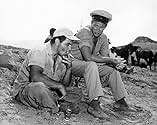IMDb RATING
6.3/10
1.2K
YOUR RATING
In 1944, US Navy specialists run a weather station in the Gobi desert where they are harassed by Japanese warplanes but aided by local Mongol nomads.In 1944, US Navy specialists run a weather station in the Gobi desert where they are harassed by Japanese warplanes but aided by local Mongol nomads.In 1944, US Navy specialists run a weather station in the Gobi desert where they are harassed by Japanese warplanes but aided by local Mongol nomads.
Max Showalter
- Walter Landers
- (as Casey Adams)
Edgar Barrier
- Yin Tang
- (uncredited)
Willis Bouchey
- Capt. Gates
- (uncredited)
James Conaty
- Admiral
- (uncredited)
Franklyn Farnum
- Quartermaster General
- (uncredited)
John Hedloe
- Pilot
- (uncredited)
Earl Holliman
- Frank Swenson
- (uncredited)
Frank Iwanaga
- Lieutenant
- (uncredited)
Storyline
Did you know
- TriviaNixon and Fallon, NV were both used as location sites, and Paiute Indians residing on a reservation in Nixon played Mongol extras.
- GoofsMcHale claims that "Gobi Desert" means "wall of spears." Actually, "Gobi" is the Mongolian word for "desert."
- Quotes
[Walter flirts successfully with a Mongolian woman]
Jenkins: Well, looks like you made a hit, Walter my boy. Tell me, how do you do it?
Walter Landers: My training as a meterorologist. I can take one look at a girl and tell weather.
- Crazy creditsOpening credits prologue: In the Navy records in Washington, there is an obscure entry reading "Saddles for Gobi."
This film is based on the story behind that entry--one of the strangest stories of World War II.
- ConnectionsEdited into All This and World War II (1976)
Featured review
While supposedly presenting “one of the strangest stories of WWII” (denoted in historical records merely by the cryptic phrase “Saddles For Gobi” – explained later), this film hardly constitutes the most engrossing or exciting war adventure to be depicted on the screen…and, besides, emerges as an even greater disappointment coming from a director of Wise’s stature! That said, the unusual desert location and attractive color cinematography makes it a pleasant – if forgettable – actioner. Apart from this, the fact that it’s one of Wise’s (and star Richard Widmark’s) rarest efforts, has made me leap at the chance of acquiring a copy of it (albeit an imperfect one, given the alarmingly frequent jerkiness of the image) – gleaned from a broadcast on French Satellite TV! – particularly in view of Widmark’s recent passing.
The interesting thing here is that, what starts off as a routine mission involving U.S. Navy personnel operating in a desert weather station, develops into a story of survival – as, following an aerial attack by the Japanese, the remaining members of the outfit trek towards the sea in an attempt to reach the Navy base on duty at Okinawa. Ironically, both the studio (Fox) and the star involved had already made a film about that campaign – Lewis Milestone’s HALLS OF MONTEZUMA (1950), which I’d watched on Italian TV but may check out again now (on DVD-R) as part of my ongoing Widmark tribute.
Amidst the typical camaraderie, the men suffer the elements, manage an unexpected alliance with a horde of Mongols (achieved by procuring the latter with saddles for their horses requisitioned from the U.S.!), are conned by a shady camel merchant, apparently betrayed to the Japanese forces by the Mongols themselves (though it transpires that the latter’s internment camp is actually close to the seashore) and then fight off the enemy on a ramshackle river boat. In the end, it’s certainly watchable and efficiently enough handled – but, as I said, the material per se isn’t inspiring enough to bring out the best from the talents involved…
The interesting thing here is that, what starts off as a routine mission involving U.S. Navy personnel operating in a desert weather station, develops into a story of survival – as, following an aerial attack by the Japanese, the remaining members of the outfit trek towards the sea in an attempt to reach the Navy base on duty at Okinawa. Ironically, both the studio (Fox) and the star involved had already made a film about that campaign – Lewis Milestone’s HALLS OF MONTEZUMA (1950), which I’d watched on Italian TV but may check out again now (on DVD-R) as part of my ongoing Widmark tribute.
Amidst the typical camaraderie, the men suffer the elements, manage an unexpected alliance with a horde of Mongols (achieved by procuring the latter with saddles for their horses requisitioned from the U.S.!), are conned by a shady camel merchant, apparently betrayed to the Japanese forces by the Mongols themselves (though it transpires that the latter’s internment camp is actually close to the seashore) and then fight off the enemy on a ramshackle river boat. In the end, it’s certainly watchable and efficiently enough handled – but, as I said, the material per se isn’t inspiring enough to bring out the best from the talents involved…
- Bunuel1976
- Apr 2, 2008
- Permalink
- How long is Destination Gobi?Powered by Alexa
Details
Box office
- Budget
- $1,340,000 (estimated)
- Runtime1 hour 30 minutes
- Color
- Aspect ratio
- 1.37 : 1
Contribute to this page
Suggest an edit or add missing content




































